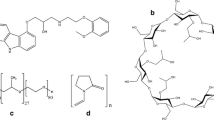Abstract
The aim of this investigation was to examine the efficacy of PhytoSolve and Phosal-based formulation (PBF) to enhance the oral bioavailability of mebudipine, which is a poorly water-soluble calcium channel blocker. The solubility of mebudipine in various oils was determined. PhytoSolve was prepared with a medium-chain triglyceride (MCT) oil (20%), soybean phospholipids (5%), and a 70% fructose solution (75%). The influence of the weight ratio of Phosal 50PG to glycerol in PBF on the mean globule size was studied with dynamic light scattering. The optimized formulation was evaluated for robustness toward dilution, transparency, droplet size, and zeta potential. The in vivo oral absorption of different mebudipine formulations (PhytoSolve, PBF, oily solution, and suspension) were evaluated in rats. The optimized PBF contained Phosal 50PG/glycerol in a 6:4 ratio (w/w). The PBF and PhytoSolve formulations were miscible with water in any ratio and did not demonstrate any phase separation or drug precipitation over 1 month of storage. The mean particle size of PhytoSolve and PBF were 138.5 ± 9.0 and 74.4 ± 2.5 nm, respectively. The in vivo study demonstrated that the oral bioavailability of PhytoSolve and PBF in rats was significantly higher than that of the other formulations. The PhytoSolve and PBF formulations of mebudipine are found to be more bioavailable compared with suspension and oily solutions during an in vivo study in rats. These formulations might be new alternative carriers that increase the oral bioavailability of poorly water-soluble molecules, such as mebudipine.




Similar content being viewed by others
REFERENCES
Mahmoudian M, Mirkhani H, Nehardani Z, Ghiaee S. Synthesis and biological activity of two new calcium-channel blockers, mebudipine and dibudipine. J Pharm Pharmacol. 1997;49(12):1229–33.
Faizi M, Janahmadi M, Mahmoudian M. The effect of mebudipine and dibudipine, two new Ca2+ channel blockers, in comparison with nifedipine on Ca2+ spikes of F 1 neuronal soma membrane in Helix aspersa. Acta Physiol Hung. 2003;90(3):243–54.
Mirkhani H, Omrani GR, Ghiaee S, Mahmoudian M. Effects of mebudipine and dibudipine, two new calcium-channel blockers, on rat left atrium, rat blood pressure and human internal mammary artery. J Pharm Pharmacol. 1999;51(5):617–22.
Bohlooli S, Keyhanfar F, Mahmoudian M. Pharmacokinetics of mebudipine, a new calcium antagonist, following single intravenous and oral administrations in rats. Biopharm Drug dispos. 2004;25(4):187–91.
Kale AA, Patravale VB. Design and evaluation of self-emulsifying drug delivery systems (SEDDS) of nimodipine. AAPS PharmSciTech. 2008;9(1):191–6.
Choi HG, Kim DD, Won Jun H, Yoo BK, Yong CS. Improvement of dissolution and bioavailability of nitrendipine by inclusion in hydroxypropyl-β-cyclodextrin. Drug Dev Ind Pharm. 2003;29(10):1085–94.
Fernandes CM, Ramos P, Falcão AC, Veiga FJB. Hydrophilic and hydrophobic cyclodextrins in a new sustained release oral formulation of nicardipine: in vitro evaluation and bioavailability studies in rabbits. J Control Release. 2003;88(1):127–34.
Hecq J, Nollevaux G, Deleers M, Fanara D, Vranckx H, Peulen O, et al. Nifedipine nanocrystals: pharmacokinetic evaluation in the rat and permeability studies in Caco-2/HT29-5M21 (co)-cultures. J drug delivery Sci Technol. 2006;16(6):437–42.
Wajda R. Emulsive water-soluble concentrates. Google Patents. 2003.
Wajda R, Zirkel J, Schaffer T. Increase of bioavailability of coenzyme Q10 and vitamin E. J Med Food. 2007;10(4):731–4.
Fricker G, Kromp T, Wendel A, Blume A, Zirkel J, Rebmann H, et al. Phospholipids and lipid-based formulations in oral drug delivery. Pharm Res. 2010;27(8):1469–86.
Carlson RP, Hartman DA, Ochalski SJ, Zimmerman JL, Glaser KB. Sirolimus (rapamycin, Rapamune) and combination therapy with cyclosporin A in the rat developing adjuvant arthritis model: correlation with blood levels and the effects of different oral formulations. Inflamm Res. 1998;47(8):339–44.
Hauss DJ. Oral lipid-based formulations. Adv Drug Deliv Rev. 2007;59(7):667–76. doi:10.1016/j.addr.2007.05.006.
Bali V, Ali M, Ali J. Study of surfactant combinations and development of a novel nanoemulsion for minimising variations in bioavailability of ezetimibe. Colloids Surf B: Biointerfaces. 2010;76(2):410–20.
Thrivikraman K, Huot RL, Plotsky PM. Jugular vein catheterization for repeated blood sampling in the unrestrained conscious rat. Brain Res Protoc. 2002;10(2):84–94.
Bohlooli S, Keyhanfar F, Mahmoudian M. High performance liquid chromatography of mebudipine: application to pharmacokinetic study. J Pharm Pharm Sci. 2001;4(3):244–7.
Hedaya MA. Basic pharmacokinetics. New York: Taylor & Francis. 2012.
Do LD, Withayyapayanon A, Harwell JH, Sabatini DA. Environmentally friendly vegetable oil microemulsions using extended surfactants and linkers. J Surfactant Deterg. 2009;12(2):91–9.
Debnath S, Rayana S, Vijay Kumar G. Nanoemulsion—a method to improve the solubility of lipophilic drugs. Int J Adv Pharm Sci. 2011;2:11.
Mahiran B. Phase behaviour, formation and characterization of palm-based esters nanoemulsion formulation containing ibuprofen. J Nanomedicine Nanotechnol. 2011; 2:113.
Trevaskis NL, Charman WN, Porter CJ. Lipid-based delivery systems and intestinal lymphatic drug transport: a mechanistic update. Adv Drug Deliv Rev. 2008;60(6):702–16.
ACKNOWLEDGMENTS
This study was a portion of Dr. Samira Khani's Ph.D. thesis, which was supported by the Tehran University of Medical Sciences and fully funded by the Phospholipid Research Center (PRC), Heidelberg. The authors gratefully acknowledge the support received from the PRC throughout the project. The authors are also thankful to Lipoid GmbH supplying key materials.
Author information
Authors and Affiliations
Corresponding author
Rights and permissions
About this article
Cite this article
Khani, S., Keyhanfar, F. Improved Oral Bioavalability of Mebudipine Upon Administration in PhytoSolve and Phosal-Based Formulation (PBF). AAPS PharmSciTech 15, 96–102 (2014). https://doi.org/10.1208/s12249-013-0039-x
Received:
Accepted:
Published:
Issue Date:
DOI: https://doi.org/10.1208/s12249-013-0039-x




